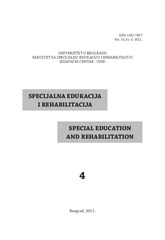Приказ основних података о документу
Verbal fluency in children with mild intellectual disability
Verbalna fluentnost kod dece sa lakom intelektualnom ometenošću
| dc.creator | Gligorović, Milica | |
| dc.creator | Buha, Nataša | |
| dc.date.accessioned | 2021-06-09T13:42:58Z | |
| dc.date.available | 2021-06-09T13:42:58Z | |
| dc.date.issued | 2011 | |
| dc.identifier.issn | 1452-7367 | |
| dc.identifier.uri | http://rfasper.fasper.bg.ac.rs/handle/123456789/508 | |
| dc.description.abstract | The aim of this research is to determine the developmental level of verbal fluency as a manifestation to generate and apply strategies, in children with mild intellectual disability (MID). The sample consists of 95 children with mild intellectual disability (MID), aged between 10 and 13.11. The participants' IQ is between 50 and 70 (M=60.43, SD=7.287). The ability to create strategies in verbal domain was assessed by verbal fluency tests - semantic and phonological. Phonological fluency was assessed by the Controlled Oral Word Association Test, while the Category Naming Test was used to assess semantic fluency. Productivity score (the total number of correct words) was used as the main variable, which indicates the quality of creating efficient strategies. Apart from that, the number of repeated words, breaking rules, and neologisms was also monitored. The results of children with MID are well behind phonological and semantic productivity of typically developing children of similar age. No statistically significant differences were determined on the Controlled Oral Word Association Test and the Category Naming Test between the participants of different ages and gender. Statistically significant differences were determined between the achievements of the participants with higher and lower intellectual abilities in the number of correct words (p lt 0.000) and breaking rules (p=0.018) on phonological fluency tasks. Statistically significant difference was also determined between the achievements of the participants with higher and lower intellectual abilities in the number of correct words (p=0.012) on semantic fluency task. The difference in the number of correct responses on phonological and semantic fluency tasks in children with MID is statistically significant (p lt 0.000). | en |
| dc.description.abstract | Istraživanje je sprovedeno sa ciljem da se utvrdi nivo razvoja verbalne fluentnosti, kao izraza sposobnosti stvaranja i primene strategija, kod dece sa lakom intelektualnom ometenošću (LIO). Uzorkom je obuhvaćeno 95-oro dece sa lakom intelektualnom ometenošću (LIO), uzrasta 10-13.11 godina. IQ ispitanika je u rasponu od 50 do 70 (AS=60,43, SD=7,287). Sposobnost stvaranja strategija u verbalnom domenu procenjena je testovima verbalne fluentnosti - semantičke i fonološke. Fonološka fluentnost procenjena je Testom kontrolisanih usmenih asocijacija, a semantička Testom kategorijalnog imenovanja. Kao osnovna varijabla, koja ukazuje na kvalitet stvaranja efikasne strategije, upotrebljen je skor produktivnosti (ukupan broj korektnih reči). Osim toga, beležen je broj ponovljenih reči, kršenja pravila i neologizama. Rezultati dece sa LIO daleko zaostaju za fonološkom i semantičkom produktivnošću dece tipičnog razvoja sličnog hronološkog uzrasta. Nisu ustanovljene statistički značajne razlike rezultata na Testu kontrolisanih usmenih asocijacija i Testu kategorijalnog imenovanja među ispitanicima različitog uzrasta i pola. Utvrđene su statistički značajne razlike postignuća među ispitanicima viših i nižih intelektunja pravila (p=0.018) na zadacima fonološke fluentnosti. Statistički značajna razlika (p=0.012) postignuća među ispitanicima viših i nižih intelektualnih sposobnosti ustanovljena je i u domenu broja korektnih reči na zadatku semantičke fluentnosti. Razlika u broju korektnih odgovora na zadacima fonološke i semantičke fluentnosti kod dece sa LIO je visoko statistički značajna (p lt 0.000). | sr |
| dc.publisher | Univerzitet u Beogradu - Fakultet za specijalnu edukaciju i rehabilitaciju, Beograd | |
| dc.relation | info:eu-repo/grantAgreement/MESTD/Basic Research (BR or ON)/179025/RS// | |
| dc.rights | openAccess | |
| dc.rights.uri | https://creativecommons.org/licenses/by-sa/4.0/ | |
| dc.source | Specijalna edukacija i rehabilitacija | |
| dc.subject | mild intellectual disability | en |
| dc.subject | planning | en |
| dc.subject | applying strategies | en |
| dc.subject | verbal fluency | en |
| dc.subject | laka intelektualna ometenost | sr |
| dc.subject | planiranje | sr |
| dc.subject | primena strategije | sr |
| dc.subject | verbalna fluentnost | sr |
| dc.title | Verbal fluency in children with mild intellectual disability | en |
| dc.title | Verbalna fluentnost kod dece sa lakom intelektualnom ometenošću | sr |
| dc.type | article | |
| dc.rights.license | BY-SA | |
| dc.citation.epage | 613 | |
| dc.citation.issue | 4 | |
| dc.citation.other | 10(4): 595-613 | |
| dc.citation.rank | M51 | |
| dc.citation.spage | 595 | |
| dc.citation.volume | 10 | |
| dc.identifier.fulltext | http://rfasper.fasper.bg.ac.rs/bitstream/id/6146/Untitled3.pdf | |
| dc.identifier.rcub | https://hdl.handle.net/21.15107/rcub_rfasper_508 | |
| dc.type.version | publishedVersion |


